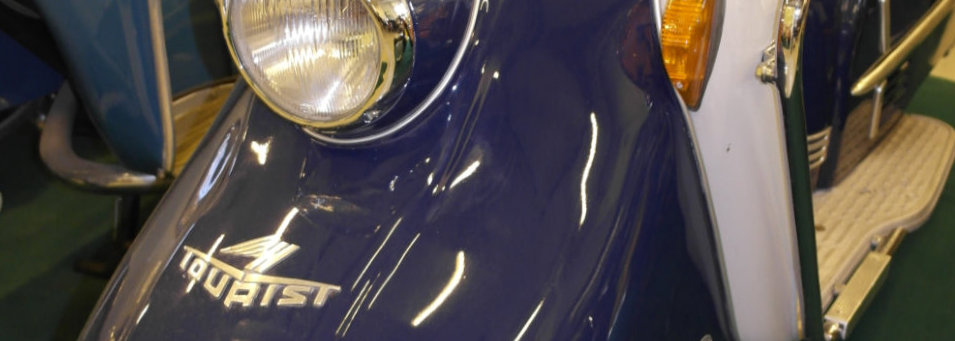




The Rolls Royce of Scooters

Heinkel Tourist - 1960
The Heinkel Tourist is a motor scooter made by Heinkel
Flugzeugwerke from 1953 to 1965. More than 100,000
were manufactured and sold.
The Tourist was sold as an upscale scooter. It was more expensive than a Vespa or a Lambretta, and was generally heavier, more comfortable, and more stable. It was available with a speedometer, a steering lock, a clock, a luggage carrier, and a spare wheel. It was referred to in England as "The Rolls-Royce of Scooters" and was advertised by a dealer in Massachusetts as "The Cadillac of Scooters". The Tourist had a tubular steel frame to which pressed steel body panels were mounted. The engine of the Tourist was mounted in the frame and drove the rear wheel by a chain enclosed in the swingarm. Thus sheltered, the chain ran in a sealed oil bath, extending its life and preventing any oil from contacting either scooter or rider. The engines used in Heinkel Tourists were 4-stroke while most other scooters of the time, including the Heinkel 150 light scooter from the 1960s, had 2-stroke enginesProduction
Heinkel's first prototype scooter was built in 1949. Production of the Tourist began in 1953. The Tourist was manufactured in five series: the 101 A0 (1953–1954), the 102 A1 (1954–1955), the 103 A0 (1955–1957), the 103 A1 (1957–1960), and the 103 A2 (1960–1965).101 A0
The Tourist 101 A0 was the first series of Heinkel Tourist, the only series with a 149 cc (9.1 cu in) engine, and the only series with a kick starter. Production began in April 1953. The three-speed transmission was actuated by a twistgrip on a tubular steel handlebar. In June 1954, the electrics were uprated from 6 V to 12 V to accommodate the addition of an electric starter at that time. Production of the 101 A0 ended two months later. 6,500 Tourist 101 A0s were built.102 A1
Production of the 102 A1 series began in July 1954. The main changes from the 101 A0 were the larger engine, which had been bored and stroked to a capacity of 174 cc (10.6 cu in), the absence of a kick starter, and the use of the 12 V electrics and an electric starter as on the last of the 101 A0s. A glove box was included behind the legshield. The speedometer was mounted on the glove box. 17,500 Tourist 102 A1s were built before production ended in August 1955.103 A0
Production of the 103 A0 series began in August 1955. 103-series Tourists had four speed transmissions and ten inch wheels, enlarged from the three speed transmissions and eight inch wheels of earlier models. The result was a larger, heavier, and thirstier scooter on one hand, and a faster, more sophisticated scooter on the other. It is stated that 34,060 Tourist 103 A0s were built before production ended in September 1957, but this production figure is disputed.103 A1
Production of the 103 A1 series began in September 1957. The tubular handlebars of previous series were replaced by a cast handlebar containing an instrument panel. The engine, while remaining the same in size, was improved by the use of a two-bearing crankshaft. The engine was now mounted to the frame with rubber mounts, improving the ride. 50,050 Tourist 103 A1s were built before production ended in June 1960.103 A2
Production of the final series of Heinkel Tourist, the 103 A2, began in August 1960. The telescopic forks of the previous series were replaced by a two-sided trailing-link fork late in the A2 production run. The rear body panel was restyled and was not interchangeable with those of earlier series. 55,000 Tourist 103 A2s were built before production of the Heinkel Tourist ended on 31 December 1965.
1960
Engine 174 cc 4-stroke OHV

Photos mainly by Matti Kreivilä. Historical facts and technical details of the vehicles provided by Wikipedia. Movies YouTube.




- Autobianchi Transformable - 1960
- Autobianchi Familiare - 1962
- Autobianchi Panoramica - 1962
- Autobianchi Cabriolet - 1963
- BMW Isetta 300 - 1956
- BMW Isetta 300 - 1959
- BMW Isetta Standard
- BMW 600 - 1959
- Bond Bug ES 700 - 1973
- Fiat Topolino - 1936
- Fiat Topolino - 1939
- Fiat Topolino - 1951
- Fiat Belvedere - 1952
- Fiat Topolino - 1954
- Fiat 600 - 1955
- Fiat 500 - 1963
- Fiat 500 - 1969
- Fiat Multipla - 1965
- Fuldamobil 4-wheel - 1958
- Fuldamobil King S7 - 1959
- GLAS Isar T700 - 1962
- Goggomobil T400 - 1959
- Goggomobil T250 - 1961
- Goggomobil T250 - 1969
- Goggomobil Coupe
- Heinkel Kabine - 1959
- Honda N600 - 1970
- Jalta Saporoshez - 1967
- Lloyd Alexander TS - 1960
- Messerschmitt KR200 - 1960
- Messerschmitt KR201
- Messerschmitt KR200 - 1963
- Messerschmitt KR200 - 1964
- NSU Prinz I - 1958
- Scootacar Mk3 - 1963
- Steyr-Puch 500 -1961
- Steyr-Puch 650 - 1964
- Trabant P 50 - 1961
- Trojan 603/198 - 1964
- Trojan 3-wheeler - 1964
- Trojan 3-wheeler - 1964
- Vespa 400 - 1959
- Victoria Spatz 250 - 1957
- ZŁndapp Janus - 1959


- About Scooters
- Apollo moped
- Cezeta 175 - 1960
- Heinkel Tourist - 1960
- Lambretta 125 - 1953
- Puch SR 150 - 1958
- Pyrkijš moped
- Suzuki Burgman 400
- Tunturi City - 1980
- Vespa 150 - 1959
- Yamaha Passola 50 - 1980
- ZŁndapp Bella w. sidecar - 1960
- ZŁndapp Bella 204 - 1960
- ZŁndapp Bella 200 Deluxe - 1963
- ZŁndapp Combinette


















